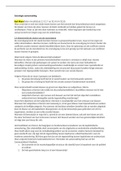Summary
Summary PSY4761. Uitwerking taak 7: Treatment in personality disorders
- Course
- Institution
PSY4761: Personality disorders. Extensive elaboration of the learning objectives associated with task 7: Treatment in Personality disorders. Includes citations and notes from the tutorial in orange. For all tasks, see the bundle.
[Show more]












